Which Sailboat?

Catalina (Capri) 14.2 Review
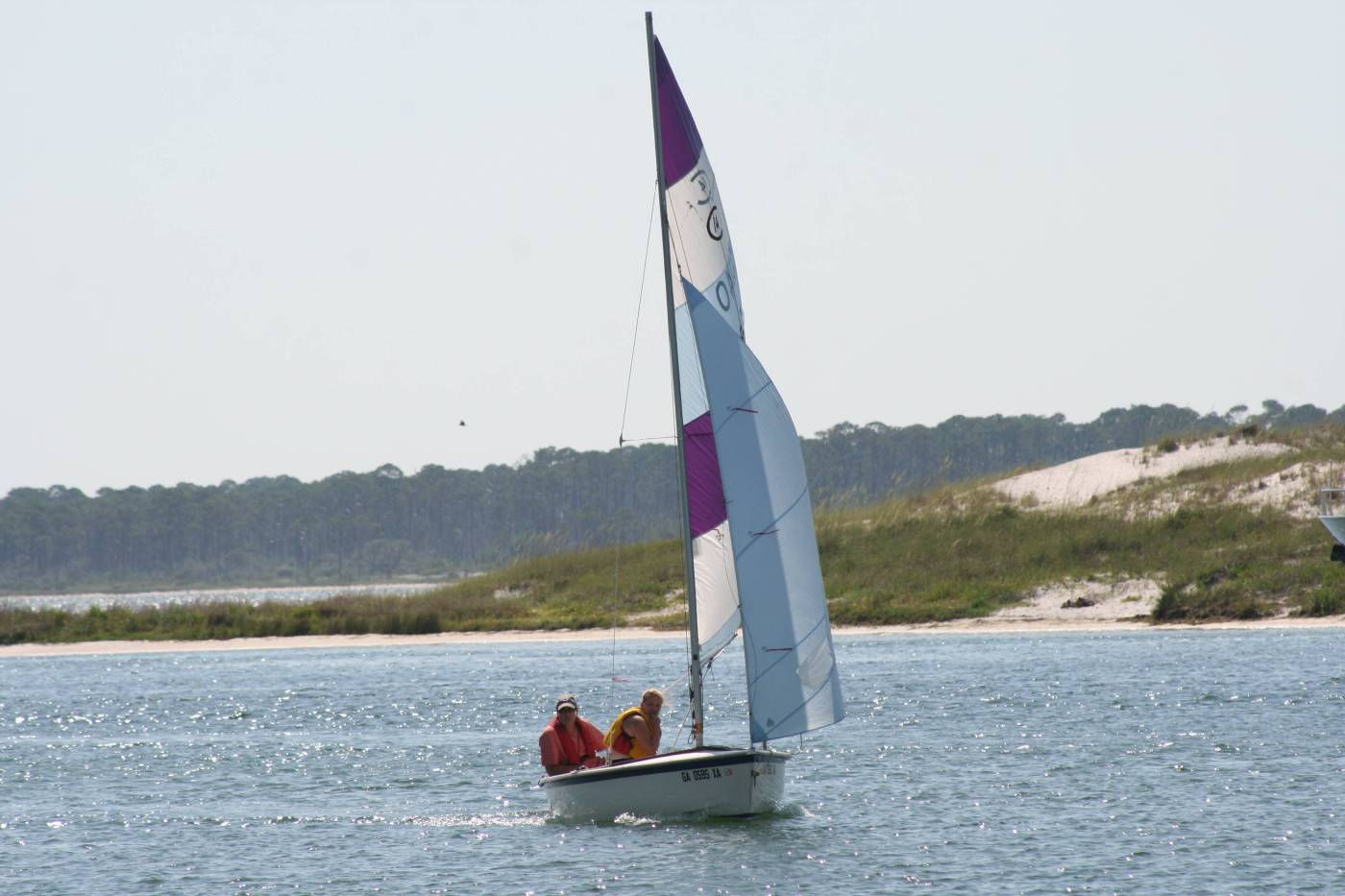
The Catalina Capri 14.2, known later as simply the Catalina 14.2, is an excellent sport sailboat and day sailer oriented toward family and youth use. The boat was designed by Ted Carpentier and Frank Butler of Catalina Yachts . Catalina derived the boat from the Omega 14 produced by Frank Butler’s Coronado Yachts prior to the formation of Catalina Yachts. After the formation of Catalina Yachts, the Omega 14 design was modified by adding a foredeck and a cuddy beneath the foredeck to create the Capri 14.2. Since 1983, over 5,200 Catalina 14.2s have been built. Production continues .
While Catalina 14.2s are frequently used for family cruising, the boat can provide an exhilarating sailing experience due to its semi-planing hull and clearly sporting sail-area-to-displacement ratio of 36. As a family sport boat and day sailer, the Catalina 14.2 is primarily composed of a large cockpit that easily holds 4 adults. One owner reports sailing inland lakes and bays of the Outer Banks in the eastern U.S. with his wife and 3 children aboard, and with the cuddy and areas beneath the cockpit seats laden with camping supplies. Forward of the dominant cockpit, a large cuddy cabin provides storage for day sail, picnic and camping supplies, batteries, and emergency equipment. As expected for a sport boat or day sailer of this size, the cuddy provides no berths, head, or galley. (If berths, galley, or head are important to you, consider the Catalina 22 , which is also easily trailered.)

The Catalina 14.2 benefits from its large production volume, long production run, that its manufacturer is still in business, and a plethora of parts continue to be available from the manufacturer and Catalina Direct . Active Catalina 14.2 class racing fleets and events exist but are limited compared to some other small sailboats such as Flying Scots, Moths, and Lasers. Presumably, this is because of the boat’s intended purpose and reputation as a family sport boat and day sailer, rather than a class racing boat.
INDENTIFYING VARIOUS CATALINA 14.2 MODELS
Three models of the Catalina 14.2 have been produced since 1983. The different models are popularly deemed “Mod 1”, “Mod 2”, and “Mod 3”. The Mod 1 models have a single open space below decks and came from the factory with a marine plywood hatch to enclose the cuddy and the rest of the space. The Mod 2 models, introduced around 1990, had a fiberglass box glued inside the entrance of the cuddy, which while preventing water intrusion into the cuddy and the rest of the hull in the event of a capsize, also made the potential storage space in the cuddy inaccessible and made maintenance of the inside of the hull more difficult. Mod 2 models had a canvas covering over the hatch to hide the box. Six years later in 1996, Catalina introduced the Mod 3, which removed the fiberglass box and included a water-tight bulkhead at the aft end of the cuddy, making for three nearly water tight areas in the hull, including the cuddy with the hatch installed and a space under each cockpit seat. Mod 3 boats were delivered with a more durable and watertight plastic hatch for the cuddy. Also on the Mod 3 boats, the wooden splash guards at the aft end of the deck where removed and instead the deck was simply rounded up from the forward end of the cockpit coamings.

The Catalina 14.2 hull is solid hand-laid fiberglass. The deck is also solid fiberglass laminate with a molded-in non-skid pattern. The deck is attached to the hull in Catalina’s standard shoebox design. Unlike larger Catalina boats intended for more rigorous sea conditions, on Mod 1 and Mod 2 models the deck is fastened to the hull only with chemical bonding – there are no mechanical fasteners. On Mod 3 boats, Catalina also through-bolted the hull-to-deck joint. Older Catalina 14.2s may suffer damage of the hull-to-deck joint so that the water-tightness of the joint is compromised. After suffering such damage, many owners strengthen the joint with mechanical fasteners with relative ease, as the joint is easily accessible at the gunwale.
Due to the design of the Catalina 14.2’s gunwale and exposed hull-to-deck joint, installation of a rub rail can serve to protect the hull-to-deck joint from damage. Installation is straightforward. Several rub rails from Taco Metals in Miami, Florida work well, particularly this white flexible vinyl model with white flexible vinyl insert .
The hull is stiffened with several plywood stringers beneath the cockpit, which also support the cockpit sole, reducing flex under foot. The seats normally flex under foot, which while initially unsettling, provides for a more comfortable ride. Due to the more rounded and thus stronger foredeck and the additional bulkhead at the aft end of the cuddy, Mod 3 boats are stiffer than Mod 1 and Mod 2 boats.
While wood stringers could be cause for alarm, few Catalina 14.2s see enough water left in the hull to cause rot. If rot is discovered, replacing the stringers can be difficult due to tight working conditions inside the hull. A few owners with rotted stringers reported solving the problem by knocking out the old wood and pouring water-resistant closed-cell expandable foam under the cockpit sole and seats. Depending on the density of the foam selected, positive buoyancy is an additional benefit of such a repair. Water-resistant closed-cell foam is crucial for this application. The TotalBoat Liquid Urethane Foam Kit, 6 Lb Density, Closed Cell for Flotation & Reinforcement works well for this application, providing both structural strength and positive buoyancy.

As delivered from the factory, the Catalina 14.2 lacks positive buoyancy materials in the hull. If the hull is allowed to fill with water, the boat will sink. On Mod 1 and Mod 3 boats, securing the cuddy hatch board fast whenever underway is paramount.
Catalina fitted foam plugs in the end of the mast on later boats, intended to provide some buoyancy in the mast to prevent turtling if capsized. However, the relatively broad beam of the boat limits the effectiveness of this design because most of the mast remains out of the water unless turtled. Many owners fit Hobie Baby Bob flotation bulbs (available on Amazon) to the top of their masts so that if the boat is knocked down, the boat does not turtle.
KEEL CONFIGURATIONS AND RUDDER
The vast majority of Catalina 14.2s were delivered with a pivoting centerboard that kicks up if grounded. The centerboard is held in place when down by a shock cord that is connected from the aft end of the top of the centerboard to the transom at the end of the cockpit. The rudder also kicks up. Earlier boats have a solid wood centerboard while later boats have a foam-cored fiberglass centerboard. Rudders are wood or foam-cored encapsulated in fiberglass. Solid HDPE rudders are available from Catalina Direct. A medium-aspect fixed keel was also offered that added 200 lbs of ballast to the boat, which makes her slower but more stable, closer to an older-style traditional day sailer. Catalina named the boats with the fixed keel the Catalina 14.2 K.
As a semi-planing boat displacing little water, the centerboard model requires no centerboard trunk. The centerboard simply slides through a slot with only a few inches separating the floor of the cockpit from the water below. With enough speed, water can spray up through this slot into the cockpit. Catalina Direct offers a canvas gasket to surround the centerboard in the slot, which prevents this spray.
The Catalina 14.2 is rigged a as a fractional sloop with a self-tacking jib. The mast is anodized aluminum and supported by a stainless steel headstay and single set of swept-back anodized aluminum spreaders with stainless steel shrouds. The shrouds include adjustable brackets rather than turnbuckles that make rig adjustments quick if not entirely precise. However, the headstay includes a turnbuckle which can be used to achieve precise rig tuning. There is no backstay, which makes un-stepping the mast easier and frees up the cockpit under sail. The rig is very light-weight so that one person can ease the mast down when un-stepping and push it up when stepping, although another person is handy to guide the mast with the forestay. All other rigging hardware is stainless steel. In 2012, Catalina changed to a Selden made rig. From the factory, the boom has no uphaul so that when the mainsail is dropped, the boom falls into the cockpit. Some owners install an uphaul, rigid boom vang, or boom kicker to prevent this.
As appropriate with a family sport boat or day sailer, all control lines are easily accessible from the cockpit. The mainsheet is managed from a stout spring-mounted pivoting block and jam cleat in the center of the cockpit. Jib sheets are managed from jam cleats on the side decks. The side decks also include a jib car track and cars that allow precise adjustment of jib sheeting angle. With sails of this size, no winches are necessary.

The cockpit of the Catalina 14.2 offers good sole depth, seat width, and coaming height for relative comfort in a sport oriented boat. The coaming height and side deck height may be considered low for some less interested in an exciting sail, or more accustomed to day sails in a Flying Scot or a more traditional day sailer design. The cockpit seats are long enough to sleep upon. The relatively small surface area of the cockpit sole, cockpit seats, side decks, and forward deck are small enough to prevent much flex.
Forward of the cockpit above the cuddy is a solid deck which is handy when dealing with the jib although feels less than secure in rough water. The side decks are reasonably wide as well.
The only brightwork on the Catalina 14.2 comprised splash guards installed at the front of the cockpit and above the hatch to the cuddy, only on Mod 1 and Mod 2 boats. These boards are easily removed for complete refinishing if necessary. Mod 3 boats had this brightwork eliminated.

The Catalina 14.2 can be a very exciting boat to sail. Hiking straps were installed throughout the cockpit from the factory. With its semi-planing hull, the boat achieves speeds great in excess of a displacement hull sailing boat. Its relatively deep centerboard and rudder provide excellent grip for pointing to windward. Riding close to the water, the boat’s occupants easily sense the speed at which they glide over the water. Due to its semi-planing hull and small size (and like most small sailboats), the Catalina 14.2’s pointing ability suffers immensely with blown out or otherwise worn out sails.
AUXILIARY POWER

The Catalina 14.2 did not come from the factory with any auxiliary propulsion, but an outboard motor mount was an option. Many owners use rowing paddles for auxiliary propulsion, but due to the beam of the boat and the orientation of the side decks, paddles are difficult to use. Many owners install small outboards, 1-3 h.p. are more than adequate for propelling the boat.
Electric trolling motors are a popular choice for auxiliary propulsion with a battery installed at the aft end of the cockpit against the transom or in the cuddy. Either way, the battery should be installed in a watertight battery box secured in place with mounting hardware. Due to the easily-driven semi-planing hull, electric trolling motors are an effective means for auxiliary propulsion, with only the smallest 30 thrust-lbs models necessary for adequate propulsion. For owners interested in sailing into a headwind off a beach or against a tide, auxiliary propulsion is paramount.

The Catalina 14.2 is easy to trailer with nearly any vehicle due to its light weight of 340 lbs. Due to its light weight, trailers require only a single axle. The relatively flat bottom and retractable centerboard make trailers intended for power boats work as an effective trailer. Trailering is easy due to the boat’s simple rig – only the forestay must be disconnected to unstep the mast.
In addition to an excellent family sport boat and day sailer, the Catalina 14.2 also makes an interesting tender for the right liveaboard or cruiser. With its weight of 340 lbs, the boat can be rigged for davits or simply towed if the sailor is not against towing a dinghy. Despite being a semi-planing boat and having an open slot for the centerboard in the cockpit sole, the Catalina 14.2 with its wide flat bottom has more initial stability than most tenders and can be well laden with crew and supplies without shipping water through the slot. However as the boat is laden, its ability to point to windward suffers greatly. The same owner who reports sailing with his family, children, and camping supplies, also reports being unable to point better than a beam reach without auxiliary power as the boat was so overladen. With a larger electric trolling motor, large battery installed, and combined with a solar panel for charging the battery, the Catalina 14.2 can power through adverse currents with excellent if not unlimited range.

Due to the excellent build quality and simplicity of the Catalina 14.2, the ready availability of spare parts, and that the manufacturer is still in business producing new Catalina 14.2s, resale values of the Catalina 14.2 remain high. New boats sell for over $6,000. Nevertheless, neglected Catalina 14.2s can be had on the used boat market at a steep discount, making the boat a potentially excellent value on the used market. Prices vary widely between $1,500 and $4,500, depending on the year of the boat, installed accessories like motors, condition of the sails, hull condition, the condition of the trailer if included with the boat. Neglected boats can be made ship shape for a modicum of investment compared with larger boats and typical tenders. At the time of writing, only two Catalina 14.2s are available on Yachtworld.com , but many making good options are available on Craigslist.
ADDITIONAL RESOURCES
Used Catalina Capri 14.2s for Sale on Craigslist Nationwide
Catalina 14.2 Brochure
CATALINA 14.2 UNDER SAIL, TACKING
CATALINA 14.2 RIGGING GUIDE
CATALINA 14.2 CLASS RACING
Share this:
2 thoughts on “ catalina (capri) 14.2 review ”.
- Pingback: 1988 Catalina Capri 14.2 sailboat for sale in Virginia | Boats & Yachts For Sale | Used Boats and New Boats For Sale
Great article – thanks! I believe I have heard that the Capri 14.2 Mod 1 had a hollow transom and that the transom was reinforced (made solid) on a later mod (2 or 3). Which mod was this, and do you know the specs of how much thrust or weight each mod can handle?
Leave a comment Cancel reply
Blog at WordPress.com.

- Already have a WordPress.com account? Log in now.
- Subscribe Subscribed
- Copy shortlink
- Report this content
- View post in Reader
- Manage subscriptions
- Collapse this bar

- Forums New posts Unanswered threads Register Top Posts Email
- What's new New posts New Posts (legacy) Latest activity New media
- Media New media New comments
- Boat Info Downloads Weekly Quiz Topic FAQ 10000boatnames.com
- Classifieds Sell Your Boat Used Gear for Sale
- Parts General Marine Parts Hunter Beneteau Catalina MacGregor Oday
- Help Terms of Use Monday Mail Subscribe Monday Mail Unsubscribe
Catalina Expo 14.2 - Any thoughts?
- Thread starter diego
- Start date Jan 28, 2004
- Forums for All Owners
- Trailer Sailors
I am planning in getting a small sailboat this summer and I have my choices narrowed down to two boats. My first choice is the Catalina Expo 14.2. My second choise is the Hunter 146. The reason to have the catalina first is because of the Smart Rig set-up. This boat will stay at the cabin by the lake, not moving around. The use is mainly sailing around the lake (MN lakes area) during the day, and getting something my kids can enjoy and we can do together. Also important is staying as dry as possible if I ever plan in taking my wife around ! I would appreciate any comments you might have regarding my choices, and any other choices I might have overlooked. Also any recommendations on reputable dealers. Thanks so much. Diego
Catalina 14 HI, I have never sailed the hunter 14 ( we now have a h23.) Our first sail boat was a catalina 14 and it was a nice boat. Easy to set up and easy to sail. It was fairly dry although we were just learning when we got it and were very careful. It was a great boat to learn on. Really I think either one would be fine. Enjoy what ever boat you get! Rob Morton S/V Euphoria
consider 2nd hand If this is your first boat, consider getting a second hand one, to see how you like it. Go to the lake you sail at and see if there is a type of dinghy that is most popular--chances are that's the one that is best suited. If there is a popular model, bound to be some for sale second hand, and not only do you save on the boat but you have a lot of experts to show you the ropes.
14.2 Diego, My first sailboat was a 14.2 and it was great, very comfortable in the cockpit. The boat is about about 500 pounds and easy to handle in and out of water. I understand your wife wanting to stay dry, that is my criteria. You don't have to get wet on the 14.2 unless you want to.
Another option Another option is the American 14-6. VERY stable boat for family and very dry. High sided so comfortable on your back and keeps everyone inside.
- This site uses cookies to help personalise content, tailor your experience and to keep you logged in if you register. By continuing to use this site, you are consenting to our use of cookies. Accept Learn more…

- Catalina 12.5 Expo
- Catalina 14.2
Catalina 14.2 Expo
- Catalina 16.5
- Catalina 22 Sport
- Catalina 22 Capri
- Catalina 275 Sport
- Catalina 315
- Catalina 355
- Catalina 385
- Catalina 425
- Catalina 445
- MAINSHEET MAGAZINE
- TRUE NORTH YACHTS
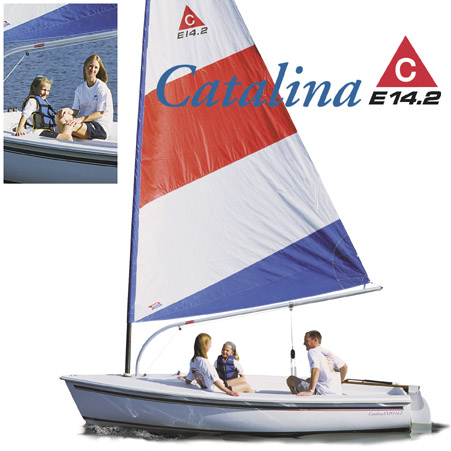
The design of the Catalina Expo 14.2 is based on the hugely successful Catalina 14.2. Having built over 5,000 Catalina 14.2s the Expo is intended as an alternative rig configuration for those new to sailing or experienced sailors who want to enjoy the fun of small boat sailing in a simple, non-technical fun boat.
The SmartRig® system consists of a tapered carbon fiber mast and deck stepped Hoyt boom. Just two lines control all the sail’s power. One line controls the sail size, while the mainsheet line shapes the sail. Strong, yet flexible, the mast bends in the gusty conditions instead of the boat heeling excessively. Having far less weight than an aluminum mast, the boat is more stable, with less tipping.
At the end of the day, just pull the furling line and the sail wraps completely around the mast. The mast and boom are free-standing and have no wires or chainplates to work around. This not only greatly decreases set-up time, but makes for a roomy, more comfortable, inviting cockpit. The one-piece aluminum Hoyt boom is up high and out of the way, with no chance of falling into the cockpit.

SPECS & STANDARD EQUIPMENT
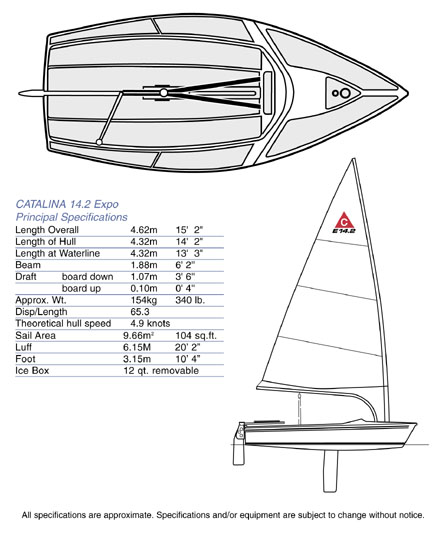
- Five Year Gel Coast Blister Protection * (2)
- Furling Mainsail, Dacron with U.V. Protection, White
- One Piece Fiberglass Hull, White
- One Piece Fiberglass Deck, White
- Molded-In Non-Skid Surfaces
- Dacron Running Rigging
- Fiberglass Composite Rudder
- Self-Bailing Cockpit
- Barney Post with Ratchet Cam Cleat
- Forward Storage Compartment
- Adjustable Outhaul
- SmartRig Rig System
FIND YOUR LOCAL DEALER
Proudly owned, designed & built in america, additional resources.
- Brochure Archives
- Associations
PARTS & TECH SUPPORT
727-544-6681
7200 Bryan Dairy Rd
Largo, FL. 33777
Great choice! Your favorites are temporarily saved for this session. Sign in to save them permanently, access them on any device, and receive relevant alerts.
- Sailboat Guide

2003 Catalina MK II
- Description
Seller's Description
Contact Keith at NineOneSeven-SixSevenZero-ThreeFourThreeOne
Boat is located in Southold, New York.
Over the years Catalina has come to be known as one of the most successful builders of the modern cruising sailboat.
Enjoying much of that success, theCatalina 36MKII has come to be one of the most popular boats on the water today.
A great layout, private aft cabin, exceptional storage, spacious galley, clever game table, stowaway dinette and a dual access head all add up to a winning formula.
In addition to comfort, the boat offers exceptional sailing characteristics and has made its mark over the years in PHRF circuits throughout the country.
Escapadehas been beautifully maintained and lightly cruised in the waters surrounding southern New Jersey and, more recently, Eastern Long Island Sound.
She has been professionally marina-maintained and stored with her own all-weather winter custom cover, included.
Can include 2015 AB 9-ft rigid bottom inflatable in good condition with 2022 6-hp Tohatsu outboard.
Boat Name: Escapade.
Year: 2003.
Located in Southold, NY.
Hull Material: Fiberglass.
Engine/Fuel Type: Single diesel.
Equipment: Dimensions: - LOA: 36 0 - Beam: 11 11 - Maximum Draft: 45 - Displacement: 14,100 lbs - Ballast: 6,600 lbs.
Engines: - Total power: 35 hp - Engine Brand: Universal - Year Built: 2002 - Engine Model: M-35BC - Engine Type: Inboard - Engine Fuel Type: Diesel - Engine Hours: 600.
Tanks: - Fresh Water Tanks: 72 gallons - Fuel Tanks: 25 gallons - Holding Tanks: 18 gallons.
Equipment: - Swim platform with swim ladder - Fresh water hot/cold shower at transom - Stern rail seating - Cockpit cushions - Edson pedestal with 40 wheel steering - Maxwell windlass #800 - Fluke anchor with chain & rode - Dodger, Bimini, connector, helm cover, sail cover - New Doyle Stack-Pack installed 2023 - New teak folding cockpit table installed 2023 - Main sail, genoa - Roller furling (new 2020) - 2 x 4D marine batteries, with battery switch - Professional Mariner battery charger - Custom winter cover - 2 x 50 shore power cords.
Rig and Sails
Auxilary power, accomodations, calculations.
The theoretical maximum speed that a displacement hull can move efficiently through the water is determined by it's waterline length and displacement. It may be unable to reach this speed if the boat is underpowered or heavily loaded, though it may exceed this speed given enough power. Read more.
Classic hull speed formula:
Hull Speed = 1.34 x √LWL
Max Speed/Length ratio = 8.26 ÷ Displacement/Length ratio .311 Hull Speed = Max Speed/Length ratio x √LWL
Sail Area / Displacement Ratio
A measure of the power of the sails relative to the weight of the boat. The higher the number, the higher the performance, but the harder the boat will be to handle. This ratio is a "non-dimensional" value that facilitates comparisons between boats of different types and sizes. Read more.
SA/D = SA ÷ (D ÷ 64) 2/3
- SA : Sail area in square feet, derived by adding the mainsail area to 100% of the foretriangle area (the lateral area above the deck between the mast and the forestay).
- D : Displacement in pounds.
Ballast / Displacement Ratio
A measure of the stability of a boat's hull that suggests how well a monohull will stand up to its sails. The ballast displacement ratio indicates how much of the weight of a boat is placed for maximum stability against capsizing and is an indicator of stiffness and resistance to capsize.
Ballast / Displacement * 100
Displacement / Length Ratio
A measure of the weight of the boat relative to it's length at the waterline. The higher a boat’s D/L ratio, the more easily it will carry a load and the more comfortable its motion will be. The lower a boat's ratio is, the less power it takes to drive the boat to its nominal hull speed or beyond. Read more.
D/L = (D ÷ 2240) ÷ (0.01 x LWL)³
- D: Displacement of the boat in pounds.
- LWL: Waterline length in feet
Comfort Ratio
This ratio assess how quickly and abruptly a boat’s hull reacts to waves in a significant seaway, these being the elements of a boat’s motion most likely to cause seasickness. Read more.
Comfort ratio = D ÷ (.65 x (.7 LWL + .3 LOA) x Beam 1.33 )
- D: Displacement of the boat in pounds
- LOA: Length overall in feet
- Beam: Width of boat at the widest point in feet
Capsize Screening Formula
This formula attempts to indicate whether a given boat might be too wide and light to readily right itself after being overturned in extreme conditions. Read more.
CSV = Beam ÷ ³√(D / 64)
Same hull and rig as the earlier version introduced in 1982 but with a larger cockpit and updated deck and interior. (Replaced with the CATALINA 375 in 2008)
Also available with a shallower draft wing keel and tall rig. Wing keel draft: 4.52’/1.38m. Dimensions for tall rig: I: 46.75’/14.25m J: 14.33’/4.37m P: 41.0’/12.5m E: 13.0’/3.96m
This listing is presented by SailboatListings.com . Visit their website for more information or to contact the seller.
View on SailboatListings.com
Embed this page on your own website by copying and pasting this code.
Similar Sailboats For Sale

1995 Catalina 36

1995 Catalina 36 Mark II Shoal Draft

1995 Catalina 36 MKII

1995 Catalina 36 mk2

1998 Catalina Mk II

1985 catalina 36 mark 1

1995 Catalina Yachts 36 MK2

2002 Catalina 36 Mkii
- About Sailboat Guide
©2024 Sea Time Tech, LLC
This site is protected by reCAPTCHA and the Google Privacy Policy and Terms of Service apply.

















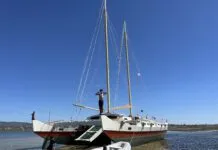
















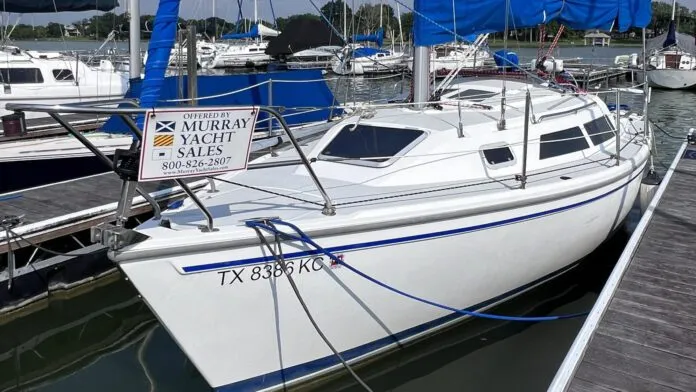
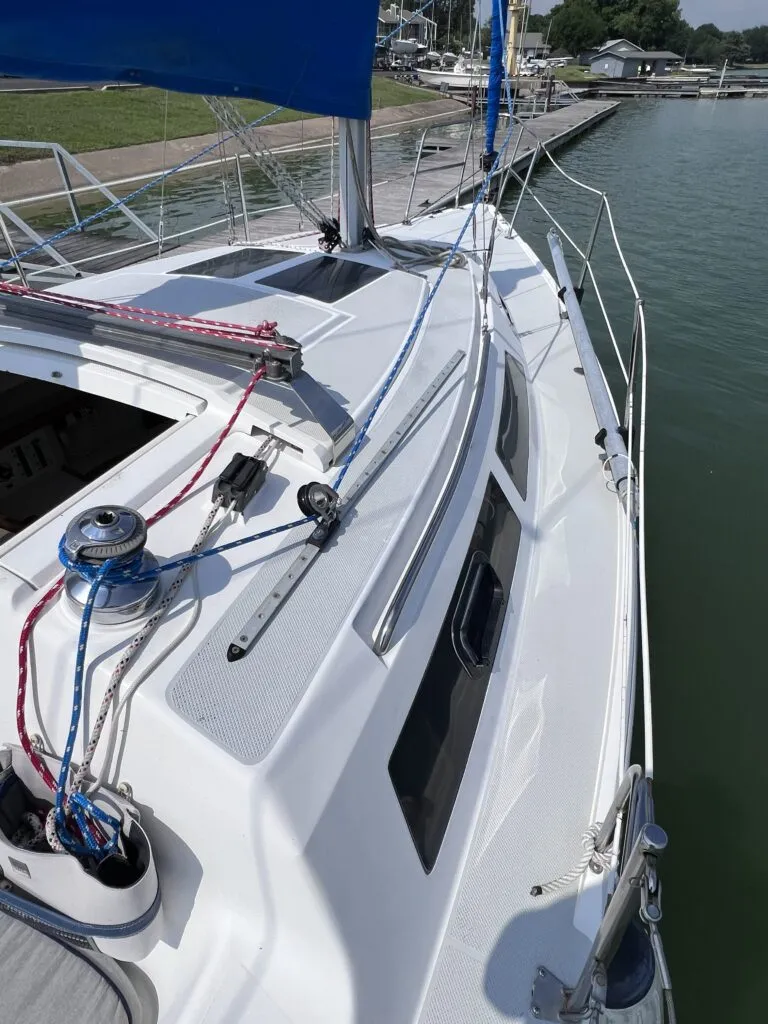
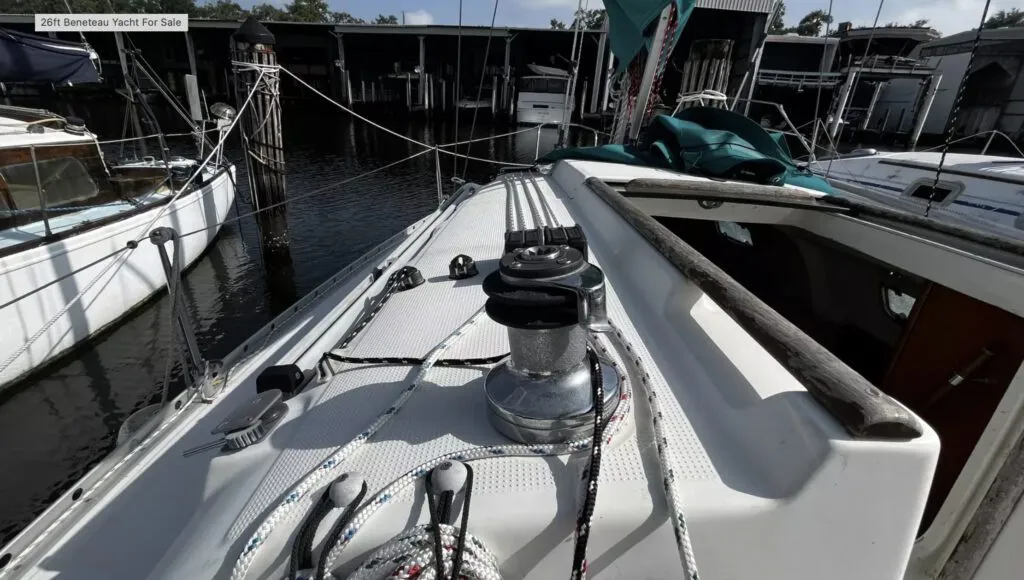
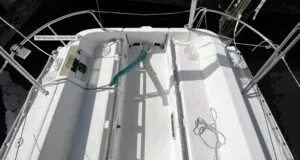
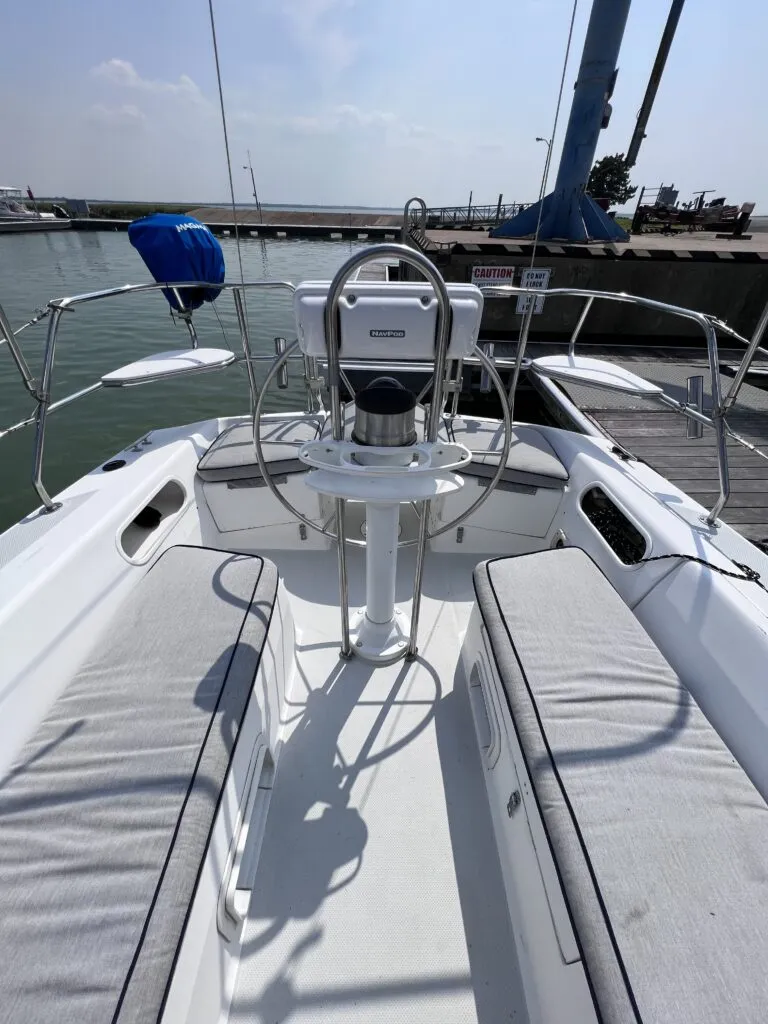
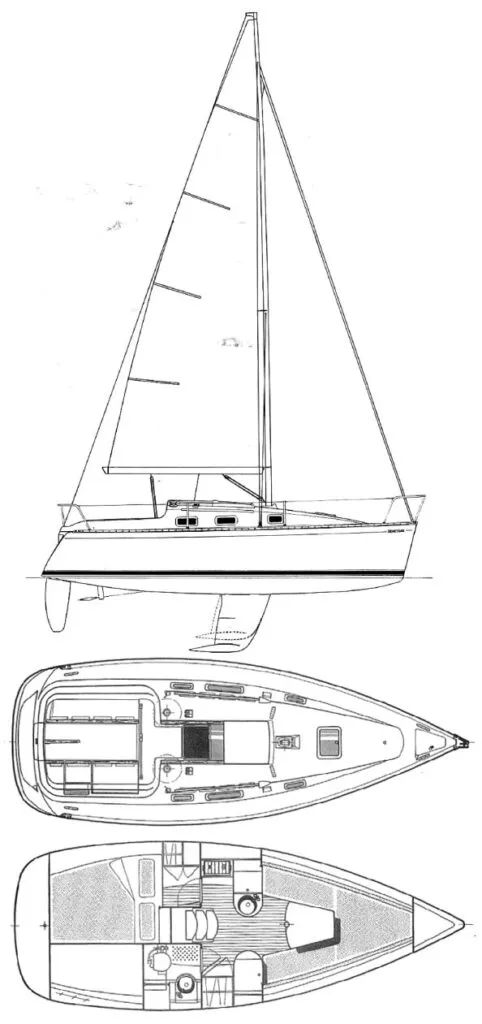
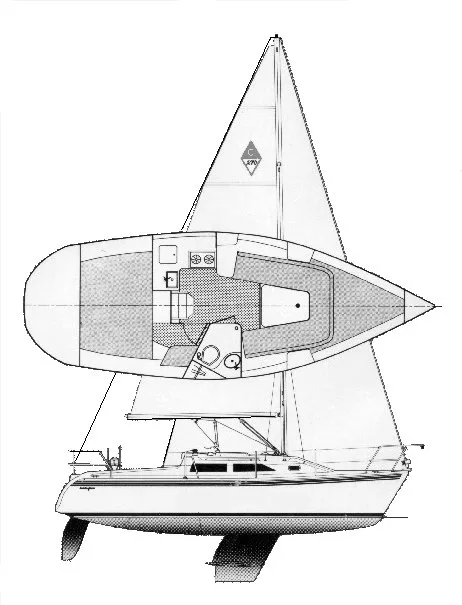

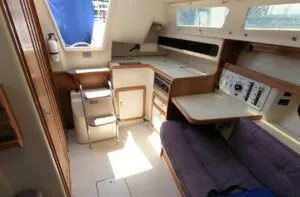
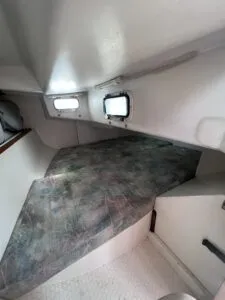






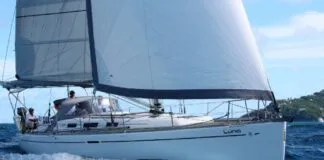
IMAGES
VIDEO
COMMENTS
The Catalina 14.2 is the perfect combination of day sailing comfort and racing performance for the active sailing family or couple. Stability and easy handling make the 14.2 an ideal boat to learn in, while the experienced skipper will enjoy the active one design racing class. The14.2 is available in two keel designs: Centerboard model with ...
The Catalina Capri 14.2, known later as simply the Catalina 14.2, is an excellent sport sailboat and day sailer oriented toward family and youth use. The boat was designed by Ted Carpentier and Frank Butler of Catalina Yachts. Catalina derived the boat from the Omega 14 produced by Frank Butler's Coronado Yachts prior to the…
A boat with a BN of 1.6 or greater is a boat that will be reefed often in offshore cruising. Derek Harvey, "Multihulls for Cruising and Racing", International Marine, Camden, Maine, 1991, states that a BN of 1 is generally accepted as the dividing line between so-called slow and fast multihulls.
2024 Catalina Expo 14.2 Expo - In stock! The design of the Catalina Expo 14.2 is based on the hugely successful Catalina 14.2. Having built over 5,000 Catalina 14.2s the Expo is intended as an alternative rig configuration for those new to sailing or experienced sailors who want to enjoy the fun of small boat sailing in a simple, non-technical fun boat.
2008 Catalina 14.2 2008 Catalina 14.2, The 14.2 is the perfect combination of day sailing comfort and racing performance for the active sailing family or couple. Stability and easy handling make the 14.2 an ideal boat to learn in, while the experienced skipper will enjoy the active one design racing class. This 14.2 is the Centerboard model.
FORGING AHEAD. From the past 50 years, and to the next 50, Catalina is devoted to providing owners and dealers with quality and value that has made Catalina America's largest sailboat builder. Frank Butler's vision and philosophy carries forward with Sharon Day, who worked alongside Frank for 48 years, at the helm of a veteran leadership team.
14.2 K. 21200 Victory Blvd.,Woodland Hills, CA 91367 Phone (818) 884-7700 FAX (818) 884-3810. www.catalinayachts.com. a 14.2 keelThe Catalina 14.2 keel model is the perfect combination of day sailing comfort for the active sailing famil. or couple. Stability and easy handling make the 14.2 an ideal boat to learn in, and experienced skippers ...
Catalina Capri 14.2 is a 14′ 2″ / 4.3 m monohull sailboat designed by Ted Carpentier and Frank V. Butler and built by Catalina Yachts starting in 1983. ... The lower a boat's ratio is, the less power it takes to drive the boat to its nominal hull speed or beyond. Read more. Formula. D/L = (D ÷ 2240) ÷ (0.01 x LWL)³ D: Displacement of the ...
Catalina 14.2 is a 15′ 1″ / 4.6 m monohull sailboat designed by Carpentier/Butler and built by Catalina Yachts starting in 1991. ... The lower a boat's ratio is, the less power it takes to drive the boat to its nominal hull speed or beyond. Read more. Formula. D/L = (D ÷ 2240) ÷ (0.01 x LWL)³ D: Displacement of the boat in pounds. LWL ...
Jan 28, 2004. #1. I am planning in getting a small sailboat this summer and I have my choices narrowed down to two boats. u000bMy first choice is the Catalina Expo 14.2.u000bMy second choise is the Hunter 146.u000bu000bThe reason to have the catalina first is because of the Smart Rig set-up. u000bThis boat will stay at the cabin by the lake ...
The design of the Catalina Expo 14.2 is based on the hugely successful Catalina 14.2. Having built over 5,000 Catalina 14.2s the Expo is intended as an alternative rig configuration for those new to sailing or experienced sailors who want to enjoy the fun of small boat sailing in a simple, non-technical fun boat.
Catalina preowned sailboats for sale by owner. Catalina used sailboats for sale by owner. Home. Register & Post. View All Sailboats. Search. ... Sailboat Added 14-Jul-2014 More Details: Catalina Capri 14.2: Length: 14.2' Beam: 6.2' Draft: 4' Year: 1996: Type: dinghy: Hull: fiberglass monohull:
A boat with a BN of 1.6 or greater is a boat that will be reefed often in offshore cruising. Derek Harvey, "Multihulls for Cruising and Racing", International Marine, Camden, Maine, 1991, states that a BN of 1 is generally accepted as the dividing line between so-called slow and fast multihulls.
California. $2,750. Description: Capri 14.2 - Excellent condition. Includes stock main and jib, North Sails racing main and jib, spinnaker, spinnaker pole, spinnaker sheets and guys, and boat cover. Shoreline anodized trailer with spare wheel. Equipment:
Boat is located in Southold, New York. Over the years Catalina has come to be known as one of the most successful builders of the modern cruising sailboat. ... 14.33'/4.37m P: 41.0'/12.5m E: 13.0'/3.96m. This listing is presented by SailboatListings.com. Visit their website for more information or to contact the seller.
A few years ago I purchased a Catalina 14.2 and hadn't sailed in years. While this might not be for everyone I decided to fly out to California for the weekend and attend the 2 day sailing class which focused exclusively on the Catalina 14.2, the intro to sailing boat of choice at the UCLA marine aquatic center in Marina Del Rey just outside of ...
September 2001-The Catalina Capri 22 is updated and is selected by Sail Magazine and it's readers as one of the Top 10 sailboats for 2001. May 2001 -Catalina 14.2 Hull number 5000 is built in Woodland Hills, CA January 2002-The Catalina 350 is introduced to enthusiastic reviews and results in 100 boats sold the first model year.
Catalina preowned sailboats for sale by owner. Catalina used sailboats for sale by owner. Home. Register & Post. View All Sailboats. Search. Avoid Fraud. ... 14.3' Topper Topaz Argo Sport Chattanooga, Tennessee Asking $14,500. 40' Freedom 40/40 Guatemala, Asking $134,900. 55' Beneteau Oceanis 55
Catalina is a boat builder in the marine industry that offers boats for sale in differing sizes on Boat Trader, with the smallest current boat listed at 20 feet in length, to the longest vessel measuring in at 47 feet, and an average length of 34.51 feet. Boat Trader currently has 189 Catalina boats for sale, including 17 new vessels and 172 ...
On the Catalina, the impression is of a more basic, but much lighter and equally airy boat. The Catalina's lightness is helped by a skylight of milk-white Plexiglas (two layers thick) aft of the mast, and more area in the main cabin ports. ... 8.25-gallon fuel tank vs. 14 gallons; 16.25-gallon water tank vs. 26 gallons; holding tank 11.5 ...
A boat with a BN of 1.6 or greater is a boat that will be reefed often in offshore cruising. Derek Harvey, "Multihulls for Cruising and Racing", International Marine, Camden, Maine, 1991, states that a BN of 1 is generally accepted as the dividing line between so-called slow and fast multihulls.